Early Church Missionaries
----------------------------------
FIRST CENTURY
12 disciples spread Gospel to known
world: James to Spain , Andrew to Russia , Paul to Asia Minor and Europe , Thomas and Bartholomew to India .
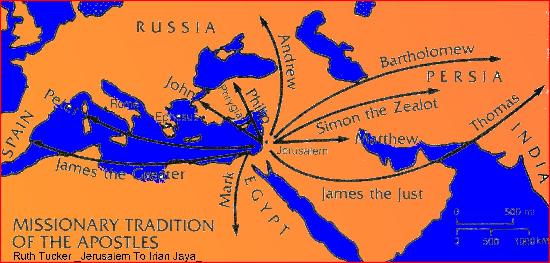 Apostle Simon the Zealot: Most legends
place his missionary work in Egypt (with Mark). According to a
sixth-century apocryphal tradition, he preached the Gospel in Persia with Jude (Judas Thaddaeus), where they
were both martyred.
Apostle Simon the Zealot: Most legends
place his missionary work in Egypt (with Mark). According to a
sixth-century apocryphal tradition, he preached the Gospel in Persia with Jude (Judas Thaddaeus), where they
were both martyred.
SOURCE: http://gallery.euroweb.hu/html/g/greco_el/1606-10/apostola/11simon.html
 St. Thomas in India : The astonishing thing is not so much the account of St. Thomas' martyrdom, but the fact that he should
have lived in here at all-in what was then a small village on the east coast of
the Indian peninsula-a very long way off from his native Palestine . Documentary evidence indicates that
active trading between the Middle East and the Malabar coast of India was in existence as far back as the
first century, B.C. It is therefore theoretically possible that St. Thomas could have crossed the Arabian Sea aboard an Arab dhow. It can only be a
gift of Grace that the faith and tradition of a small community of the early
Christians in India have remained alive and vibrant
throughout nearly two thousand years. There is no good reason to doubt the
living tradition of St. Thomas Christians that the Apostle arrived in
Kodungalloor (Muziris) in Kerala in 52 AD, preached the gospel, established
seven churches, and moved on to other kingdom, returning to Madras (Mylapore) in
72 AD where he was martyred that year...
St. Thomas in India : The astonishing thing is not so much the account of St. Thomas' martyrdom, but the fact that he should
have lived in here at all-in what was then a small village on the east coast of
the Indian peninsula-a very long way off from his native Palestine . Documentary evidence indicates that
active trading between the Middle East and the Malabar coast of India was in existence as far back as the
first century, B.C. It is therefore theoretically possible that St. Thomas could have crossed the Arabian Sea aboard an Arab dhow. It can only be a
gift of Grace that the faith and tradition of a small community of the early
Christians in India have remained alive and vibrant
throughout nearly two thousand years. There is no good reason to doubt the
living tradition of St. Thomas Christians that the Apostle arrived in
Kodungalloor (Muziris) in Kerala in 52 AD, preached the gospel, established
seven churches, and moved on to other kingdom, returning to Madras (Mylapore) in
72 AD where he was martyred that year...
The Orthodox Church in India is one of the 37 Apostolic Churches,
dating from the time of the disciples of Christ. Nine of them were in Europe and 28 in Asia and Africa . Today it belongs to the family of the
five Oriental Orthodox Churches, which include Syria , Egypt , Ethiopia and Armenia , and to the wider stream of the world's
Orthodox Churches, comprising in all over 150 million Eastern Christians. It
has a strength of over 2.5 million members in about 1500 parishes mainly in
Kerala and increasingly spread all over India and in many parts of the globe.
(SOURCE: http://www.indian-orthodox.co.uk/historical.htm)
----------------------------------
SECOND CENTURY
POLYCARP - One of the most widely-publicised
martyrs in the years following the New Testament was Polycarp, the much-loved
bishop of Smyrna (Turkey)… For some 50 years he wielded powerful
influence in his position. It was in AD156 that anti-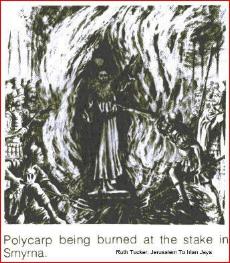 Christian persecution broke out in the
province of Asia. Civil authorities, for reasons not
fully clear, decided to kill a few Christians.
Christian persecution broke out in the
province of Asia. Civil authorities, for reasons not
fully clear, decided to kill a few Christians.
Polycarp was immediately feared to be a
likely target, so local believers insisted that he take refuge in a secluded
area. His period of hiding was short-lived. After torturing a servant, the
soldiers learned his whereabouts and found him hiding in a hayloft.
But execution, it was learned, was no
what the authorities wanted. What they really wanted was a denial of his faith.
What a victory that would be for paganism and what a blow to the “cult” of
Jesus. “What harm is there in saying, “Caesar is Lord’ and offering incense and
saving yourself,” the officials pleaded with him, “Have respect for your age…
take the oath and I will let you go.” But Polycarp, with his face set, looked
at all the crowd in the stadium and waved his hand towards them, sighed, looked
up into heaven and said, “Eighty and six years have I been His servant, and He
has never done me wrong. How can I blaspheme my king who saved me? … The fire
you threaten burns for a time and is soon extinguished; there is a fire you
know not of - the fire of the judgement to come and of eternal punishment,
reserved for the ungodly. But why do you hesitate? Do what you want.” So he was
burned at the stake.
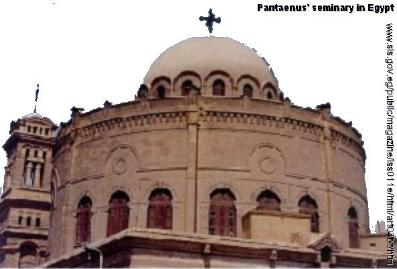 PANTAENUS: The towering stone structure of the
Greek Orthodox Church of Mar Girgis greets you as you step out of the metro station.
Centuries ago, Persian, Greek, and then Roman soldiers doing sentry duty atop
this tower would have been looking down at the River Nile instead of a metro line,
and the ground surrounding the fortress would be some 10 metres lower than its
current level...
PANTAENUS: The towering stone structure of the
Greek Orthodox Church of Mar Girgis greets you as you step out of the metro station.
Centuries ago, Persian, Greek, and then Roman soldiers doing sentry duty atop
this tower would have been looking down at the River Nile instead of a metro line,
and the ground surrounding the fortress would be some 10 metres lower than its
current level...
Pantaenus was born in Alexandria at the beginning of the second
Gregorian century. It seemed that Pantaenus and his contemporary Clement of
Alexandria were ... veterans in sciences and wisdom of the ancient, as well as
their professionalism in Christian principles. In 181 AD, Pantaenus was
appointed principal of the Seminary. He remained in his position till he was
chosen by Pope Dimitros to preach in India , after his Holiness had received a
letter from Indians seeking for a leading Christian figure to teach them
Christian faith. Pantaenus welcomed this request entrusting to Clement of
Alexandria to take over the reins of the Seminary in 190 AD till his return.
Pantaenus headed for India to propagate the Gospels...
Meanwhile, Christians realized the life
of Jesus must be translated into Egyptian language. Pantaenus assumed this
charge, but he was encountered with the inaccuracy of the hieroglyphic language
in the pronunciation of some paragraphs and accents, so he added six letters of
alphabet to the hieroglyphic. Such a work was undertaken by 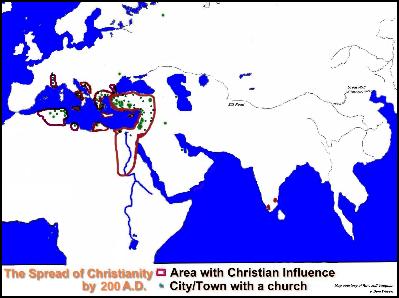 Pantaenus in cooperation with his
disciples till it was accomplished. He, therefore, was able to translate the
Holy Bible for the Egyptians in their own language for the availability to
study it at their homes and churches. By this time, hieroglyphic was replaced
by Greek language. After his nomination for a second time as Principal of the
Seminary, Pantaenus lived a short time and died in 190 AD...
Pantaenus in cooperation with his
disciples till it was accomplished. He, therefore, was able to translate the
Holy Bible for the Egyptians in their own language for the availability to
study it at their homes and churches. By this time, hieroglyphic was replaced
by Greek language. After his nomination for a second time as Principal of the
Seminary, Pantaenus lived a short time and died in 190 AD...
SOURCE: Egypt Magazine October 1997 -
http://www.sis.gov.eg/public/magazine/iss011e/html/art04txt.htm
Northwest Africa - Latin - Tertullian wrote “We are but
of yesterday, and we have filled every place among you - cities, islands,
fortresses, towns, market-places, the very camp, tribes, companies, palace,
senate, forum…” (Apologeticus 37)
----------------------------------
THIRD CENTURY
Gregory Thaumaturgos of Pontus, Asia Minor : was born and reared a pagan in a wealthy family. Tutoured
in his school subjects by Origen, he was converted and returned to Pontus , where he was made bishop against his
protestations in 240. He gave himself to completing the conversion of the
populace of his diocese. When he died, about 30 years later, the overwhelming
majority had accepted the Christian faith. It is said that when he became
bishop, he found only 17 Christians in his see and that at his death only
17 remained pagan! In achieving this mass conversion, Gregory made the transition
as easy as possible, substituting festivals in honor of Christian martyrs for
the feasts of the old gods. (SOURCE: Latourette, A History of Christianity,
p.76)
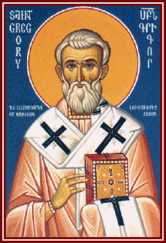 Gregory the Illuminator of Armenia : Gregory seems to have been of the Armenian aristocracy
and to have become a Christian while in exile in Asia Minor . Returning to Armenia and seeking to propagate his new faith,
Gregory encountered persecution. Then he won the king, Tradt, by name. Why the
king became a Christian we can only conjecture, but with the consent of his
nobles he supported Gregory. The compliant population rapidly moved over to the
new faith. Many of the shrines of the pre-Christian paganism were transferred,
together with their endowments , to the service of Christianity, and numbers of
pagan priests or their sons passed over into the body of Christian clergy.
Gregory the Illuminator of Armenia : Gregory seems to have been of the Armenian aristocracy
and to have become a Christian while in exile in Asia Minor . Returning to Armenia and seeking to propagate his new faith,
Gregory encountered persecution. Then he won the king, Tradt, by name. Why the
king became a Christian we can only conjecture, but with the consent of his
nobles he supported Gregory. The compliant population rapidly moved over to the
new faith. Many of the shrines of the pre-Christian paganism were transferred,
together with their endowments , to the service of Christianity, and numbers of
pagan priests or their sons passed over into the body of Christian clergy.
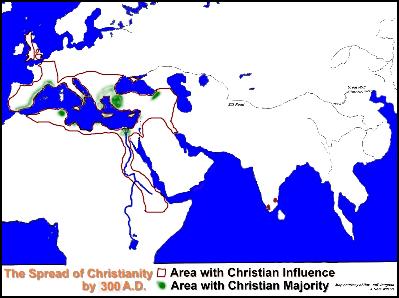 Here is an instance of a group adoption
of the Christian faith engineered by the accepted leaders and issuing in an
ecclesiastical structure which became identified with a particular people or
state. To this day the Armenian Church has been known by Gregory’s name and is
a symbol of Armenian nationalism. (SOURCE: Latourette, A History of
Christianity, p.79)
Here is an instance of a group adoption
of the Christian faith engineered by the accepted leaders and issuing in an
ecclesiastical structure which became identified with a particular people or
state. To this day the Armenian Church has been known by Gregory’s name and is
a symbol of Armenian nationalism. (SOURCE: Latourette, A History of
Christianity, p.79)
----------------------------------
FOURTH CENTURY
Constantine : invaded Italy on his march towards Rome and was faced with the army of his
first formidable opponent, Maxentius. Apparently he knew that Maxentius was
relying on pagan magic and felt the need of a more powerful supernatural force
to offset it. Years later he told his friend, Bishop Eusebius, the most eminent
of early Church historians that ,after noon, as he was praying, he had a vision
of a cross of light in the heavens bearing the inscription, “conquer by this” …
Constantine was victor, the winning battle being at the Milvian Bridge, near
Rome, and he therefore took possession of the capitol. His faith in the
efficacy of Christianity was thus won, and he supported Christianity along with
other pagan religions in his realm. Latourette, A History of Christianity,
p.91.
 Ulfilias: T35 The Visigoths, or West Goths , a warlike people, lived along the
Roman frontier west of the Black Sea . After they had been "Christianized," Ulfilas
(311-382), their bishop, saw they needed the Bible in their own tongue,
"to speak to their hearts." First, Ulfilas had to make an alphabet.
He knew that neither the Greek nor the Roman alphabet would fit a Germanic
language. He chose from these alphabets only the letters that corresponded to
the speech sounds of Visigoth. For sounds for which there were no letters, he
used runes, an early Germanic alphabet of limited use. With this, he translated
the Bible.
Ulfilias: T35 The Visigoths, or West Goths , a warlike people, lived along the
Roman frontier west of the Black Sea . After they had been "Christianized," Ulfilas
(311-382), their bishop, saw they needed the Bible in their own tongue,
"to speak to their hearts." First, Ulfilas had to make an alphabet.
He knew that neither the Greek nor the Roman alphabet would fit a Germanic
language. He chose from these alphabets only the letters that corresponded to
the speech sounds of Visigoth. For sounds for which there were no letters, he
used runes, an early Germanic alphabet of limited use. With this, he translated
the Bible.
The Visigoths migrated west and were the
first to conquer Rome (A.D. 410) Their aim, however, was not so much to destroy but
to acquire the benefits of civilization. It was largely due to the work of
Ulfilas that these plunderers became peacemakers.
SOURCE: 1999-2000 JAARS Museum of the Alphabet [info@jaars.org]
 Chrysostom: Towards the end of the year 397, Chrysostom
was chosen… against his will, archbishop of Constantinople . He was hurried away from Antioch by a military escort, to avoid a
commotion in the congregation and to make resistance useless…
Chrysostom: Towards the end of the year 397, Chrysostom
was chosen… against his will, archbishop of Constantinople . He was hurried away from Antioch by a military escort, to avoid a
commotion in the congregation and to make resistance useless…
Chrysostom soon gained by his eloquent
sermons the admiration of the people, of the weak Emperor Arcadius, and, at
first, even of his wife Eudoxia... He extended his pastoral care to the
Goths who were becoming numerous in Constantinople, had a part of the Bible
translated for them, often preached to them himself through an interpreter, and
sent missionaries to the Gothic and Scythian tribes on the Danube. He continued
to direct by correspondence those missionary operations even during his exile.
For a short time he enjoyed the height of power and popularity.
But he also made enemies by his
denunciations of the vices and follies of the clergy and aristocracy. He
emptied the Episcopal palace of its costly plate and furniture and sold it for
the benefit of the poor and the hospitals. He introduced his strict ascetic
habits and reduced the luxurious household of his predecessors to the strictest
simplicity. He devoted his large income to benevolence. He refused invitations
to banquets, gave no dinner parties, and ate the simplest fare in his solitary
chamber. He denounced unsparingly luxurious habits in eating and dressing, and
enjoined upon the rich the duty of almsgiving to an extent that tended to
increase rather than diminish the number of beggars who swarmed in the streets
and around the churches and public baths. He disciplined the vicious clergy and
opposed the perilous and immoral habit of unmarried priests of living under the
same roof with "spiritual sisters." …Chrysostom's unpopularity was
increased by his irritability and obstinacy (which some attributed to an
ascetic lifestyle that ruined his stomach). The Empress Eudoxia was jealous of
his influence over Arcadius and angry at his uncompromising severity against
sin and vice. She became the chief instrument of his downfall… The saint died
in the city of Comene on September 14th in the year 407 on his way to a place
of exile, having been condemned by the intrigues of the empress Eudoxia because
of his daring denunciation of the vices ruling over Constantinople . The last words on his lips were,
"Glory be to God for all things!"
SOURCE: www.chrysostom.org
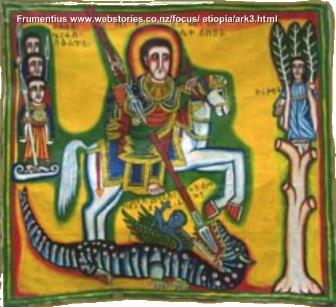 AXUM : Frumentius: A Christian philosopher from Tyre called Meropius travelled to India with his wards, Frumentious and
Aedsius. On the way home, they fell prey to pirates in the Red Sea and were shipwrecked. Meropius and the
rest of the ship’s company were massacred, but the people of Aksum found the two boys sitting under a
tree, studying. They were welcomed at the court of the King, Ella Amida;
Aedsius became his cupbearer, and Frumentius became his treasurer and
secretary. Then the King died, Frumentius acted as regent until prince Ezana
came of age. When the prince came into his inheritance, Aedisius went back to Tyre and Frumentius went to Alexandria, Egypt to ask for a bishop for the Christians
of Aksum. Athanasius responded by consecrating Frumentius and sending him back
to Aksum as its first bishop. During his reign
as king of Aksum , Ezana’s monument s and coins provide a fascinating
mirror of his gradual adoption of Christianity. His earliest inscriptions are
dedicated to the South Arabian gods Astar, Baher, and Meder, later the invoke
the “Lord of Heaven,” and finally, the Trinity. Christianity became the
official faith of that state! SOURCES: Latourette, A History of
Christianity, p.104, and Isichei, A History of Christianity in Africa,
p.32.
AXUM : Frumentius: A Christian philosopher from Tyre called Meropius travelled to India with his wards, Frumentious and
Aedsius. On the way home, they fell prey to pirates in the Red Sea and were shipwrecked. Meropius and the
rest of the ship’s company were massacred, but the people of Aksum found the two boys sitting under a
tree, studying. They were welcomed at the court of the King, Ella Amida;
Aedsius became his cupbearer, and Frumentius became his treasurer and
secretary. Then the King died, Frumentius acted as regent until prince Ezana
came of age. When the prince came into his inheritance, Aedisius went back to Tyre and Frumentius went to Alexandria, Egypt to ask for a bishop for the Christians
of Aksum. Athanasius responded by consecrating Frumentius and sending him back
to Aksum as its first bishop. During his reign
as king of Aksum , Ezana’s monument s and coins provide a fascinating
mirror of his gradual adoption of Christianity. His earliest inscriptions are
dedicated to the South Arabian gods Astar, Baher, and Meder, later the invoke
the “Lord of Heaven,” and finally, the Trinity. Christianity became the
official faith of that state! SOURCES: Latourette, A History of
Christianity, p.104, and Isichei, A History of Christianity in Africa,
p.32.
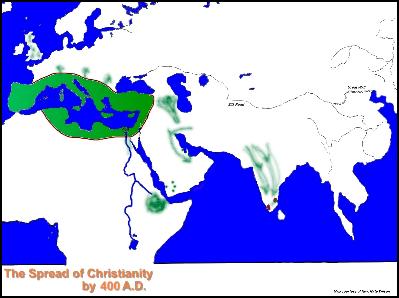 Egyptian Coptic Church which grew in this time period was not
Hellenistic, but made of common people who spoke Egyptian Coptic. They more
readily embraced the otherworldly emphasis of Gnosticism, but were persecuted
severely - many fled to the desert. One church father wrote, “If the Tiber flooded or if the Nile failed to flood, there was a cry of
‘Christians to the lion!’” (Tertullian, Apologeticus 40)
Egyptian Coptic Church which grew in this time period was not
Hellenistic, but made of common people who spoke Egyptian Coptic. They more
readily embraced the otherworldly emphasis of Gnosticism, but were persecuted
severely - many fled to the desert. One church father wrote, “If the Tiber flooded or if the Nile failed to flood, there was a cry of
‘Christians to the lion!’” (Tertullian, Apologeticus 40)
Likewise in North Africa , the poorer classes that remained
faithful during earlier persecutions formed the Donatist church. They opposed
the more wealthy Roman Catholic church leaders, such as Augustine. They were,
however, active in providing medical care for plague victims in the city of Carthage . (SOURCE: History of Christianity in
Africa )
ARABIA : Theophilus the Indian was sent from Rome and converted the king of Southern Arabia , planted 4 churches in Yemen . Abdisha builds monastery in Bahrain . (SOURCE: Samuel Moffat A History of Christianity in Asia )
-----------------------------------
FIFTH CENTURY
Many European tribes were converted.
Patrick worked among the Irish, Ninian among the Picts, and there were many
others.
CONFESSION OF PATRICK- Translated from
the Latin by Ludwig Bieler
I am Patrick, a sinner,
most unlearned, the least of all the faithful, and utterly despised by many. My
father was Calpornius, a deacon, son of Potitus, a priest, of the village
Bannavem Taburniæ; he had a country seat nearby, and there I was taken captive.
I was then about sixteen years of age. I did not know the true God. I was taken
into captivity to Ireland with many thousands of people---and deservedly so,
because we turned away from God, and did not keep His commandments, and did not
obey our priests, who used to remind us of our salvation. And the Lord brought
over us the wrath of his anger and scattered us among many nations, even unto
the utmost part of the earth, where now my littleness is placed among
strangers. And there the Lord opened the sense of my unbelief that I might at
last remember my sins and be converted with all my heart to the Lord my God,
who had regard for my abjection, and mercy on my youth and ignorance, and
watched over me before I knew Him, and before I was able to distinguish between
good and evil, and guarded me, and comforted me as would a father his son.
Hence I cannot be silent---nor, indeed, is it expedient---about the great
benefits and the great grace which the lord has deigned to bestow upon me in
the land of my captivity; for this we can give to God in return after having
been chastened by Him, to exalt and praise His wonders before every nation that
is anywhere under the heaven.
THEOLOGY: Because there is no other God,
nor ever was, nor will be, than God the Father unbegotten, without beginning,
from whom is all beginning, the Lord of the universe, as we have been taught;
and His son Jesus Christ, whom we declare to have always been with the Father,
spiritually and ineffably begotten by the Father before the beginning of the
world, before all beginning; and by Him are made all things visible and
invisible. He was made man, and, having defeated death, was received into
heaven by the Father; and He hath given Him all power over all names in heaven,
on earth, and under the earth, and every tongue shall confess to Him that Jesus
Christ is Lord and God, in whom we believe, and whose advent we expect soon to
be, judge of the living and of the dead, who will render to every man according
to his deeds; and He has poured forth upon us abundantly the Holy Spirit, the
gift and pledge of immortality, who makes those who believe and obey sons of
God and joint heirs with Christ; and Him do we confess and adore, one God in
the Trinity of the Holy Name...
ESCAPE FROM SLAVERY: But after I came to
Ireland---every day I had to tend sheep, and many times a day I prayed---the
love of God and His fear came to me more and more, and my faith was
strengthened… And there one night I heard in my sleep a voice saying to me: `It
is well that you fast, soon you will go to your own country.' And again, after
a short while, I heard a voice saying to me: `See, your ship is ready.' ...
then I took to flight, and I left the man with whom I had stayed for six years.
And I went in the strength of God who directed my way to my good, and I feared
nothing until I came to that ship... And after three days we reached land, and
for twenty-eight days we travelled through deserted country. And they lacked
food, and hunger overcame them; and the next day the captain said to me: `Tell
me, Christian: you say that your God is great and all-powerful; why, then, do
you not pray for us? As you can see, we are suffering from hunger; it is
unlikely indeed that we shall ever see a human being again.' I said to them
full of confidence: `Be truly converted with all your heart to the Lord my God,
because nothing is impossible for Him, that this day He may send you food on
your way until you be satisfied; for He has abundance everywhere.' And, with
the help of God, so it came to pass: suddenly a herd of pigs appeared on the
road before our eyes, and they killed many of them...
CALL BACK TO IRELAND: And again after a
few years I was in Britain with my people. who received me as their son, and
sincerely besought me that now at last, having suffered so many hardships, I
should not leave them and go elsewhere. And there I saw in the night the vision
of a man, whose name was Victoricus, coming as it were from Ireland, with
countless letters. And he gave me one of them, and I read the opening words of
the letter, which were, `The voice of the Irish'; and as I read the beginning
of the letter I thought that at the same moment I heard their voice---they were
those beside the Wood of Voclut, which is near the Western Sea---and thus did
they cry out as with one mouth: `We ask thee, boy, come and walk among us once
more.' And I was quite broken in heart, and could read no further, and so I
woke up. Thanks be to God, after many years the Lord gave to them according to
their cry...
BRITISH OPPOSITION: For many tried to prevent
this my mission; they would even talk to each other behind my back and say:
`Why does this fellow throw himself into danger among enemies who have no
knowledge of God?' … And when I was attacked by a number of my seniors who came
forth and brought up my sins against my laborious episcopate... they
found---after thirty years!---a confession I had made before I was a deacon. In
the anxiety of my troubled mind I confided to my dearest friend what I had done
in my boyhood one day, nay, in one hour, because I was not yet strong. I know
not, God knows---whether I was then fifteen years old: and I did not believe in
the living God... Therefore I give Him thanks who hath strengthened me in
everything, as He did not frustrate the journey upon which I had decided, and
the work which I had learned from Christ my Lord; but I rather felt after this
no little strength, and my trust was proved right before God and men... Hence,
then, I give unwearied thanks to God, who kept me faithful in the day of my
temptation, so that today I can confidently offer Him my soul as a living
sacrifice---to Christ my Lord, who saved me out of all my troubles. Thus I can
say: `Who am I, 0 Lord, and to what hast Thou called me, Thou who didst assist
me with such divine power that to-day I constantly exalt and magnify Thy name
among the heathens wherever I may be, and not only in good days but also in
tribulations?' ...
SCRIPTURE FULFILLED IN MISSION TO
IRELAND: For I am very much God's debtor, who gave me such grace that many
people were reborn in God through me and afterwards confirmed, and that clerics
were ordained for them everywhere, for a people just coming to the faith, whom
the Lord took from the utmost parts of the earth, as He once had promised
through His prophets: To Thee the gentiles shall come from the ends of the
earth and shall say: `How false are the idols that our fathers got for
themselves, and there is no profit in them'; and again: `I have set Thee as a
light among the gentiles, that You may be for salvation unto the utmost part of
the earth.' And there I wish to wait for His promise who surely never deceives,
as He promises in the Gospel: They shall come from the east and the west, and
shall sit down with Abraham and Isaac and Jacob---as we believe the faithful
will come from all the world.
 FISHERS OF MEN: For that reason,
therefore, we ought to fish well and diligently, as the Lord exhorts in advance
and teaches, saying: Come ye after me, and I will make you to be fishers of
men. And again He says through the prophets: Behold, I send many fishers and
hunters, says God, and so on. Hence it was most necessary to spread our nets so
that a great multitude and throng might be caught for God, and that there be
clerics everywhere to baptize and exhort a people in need and want, as the Lord
in the Gospel states, exhorts and teaches, saying: Going therefore now, teach
ye all nations, baptizing them in the name of the Father, and the Son, and the
Holy Spirit, teaching them to observe all things whatsoever I have commanded
you: and behold I am with you all days even to the consummation of the world.
And again He says: Go ye therefore into the whole world, and preach the Gospel
to every creature. He that believeth and is baptized shall be saved; but he
that believeth not shall be condemned. And again: This Gospel of the kingdom
shall be preached in the whole world for a testimony to all nations, and then
shall come the end. And so too the Lord announces through the prophet, and
says: And it shall come to pass, in the last days, says the Lord, I will pour
out of my Spirit upon all flesh; and your sons and your daughters shall
prophesy, and your young men shall see visions, and your old men shall dream
dreams. And upon my servants indeed, and upon my handmaids will I pour out in
those days of my Spirit, and they shall prophesy. And in Isaiah, He says: `I
will call that which was not my people, my people; ...and her that had not
obtained mercy, one that hath obtained mercy. And it shall be in the place
where it was said: ``You are not my people,'' there they shall be called the
sons of the living God.'
FISHERS OF MEN: For that reason,
therefore, we ought to fish well and diligently, as the Lord exhorts in advance
and teaches, saying: Come ye after me, and I will make you to be fishers of
men. And again He says through the prophets: Behold, I send many fishers and
hunters, says God, and so on. Hence it was most necessary to spread our nets so
that a great multitude and throng might be caught for God, and that there be
clerics everywhere to baptize and exhort a people in need and want, as the Lord
in the Gospel states, exhorts and teaches, saying: Going therefore now, teach
ye all nations, baptizing them in the name of the Father, and the Son, and the
Holy Spirit, teaching them to observe all things whatsoever I have commanded
you: and behold I am with you all days even to the consummation of the world.
And again He says: Go ye therefore into the whole world, and preach the Gospel
to every creature. He that believeth and is baptized shall be saved; but he
that believeth not shall be condemned. And again: This Gospel of the kingdom
shall be preached in the whole world for a testimony to all nations, and then
shall come the end. And so too the Lord announces through the prophet, and
says: And it shall come to pass, in the last days, says the Lord, I will pour
out of my Spirit upon all flesh; and your sons and your daughters shall
prophesy, and your young men shall see visions, and your old men shall dream
dreams. And upon my servants indeed, and upon my handmaids will I pour out in
those days of my Spirit, and they shall prophesy. And in Isaiah, He says: `I
will call that which was not my people, my people; ...and her that had not
obtained mercy, one that hath obtained mercy. And it shall be in the place
where it was said: ``You are not my people,'' there they shall be called the
sons of the living God.'
CANNOT RETURN TO ENGLAND: Hence, how did
it come to pass in Ireland that those who never had a knowledge of God, but
until now always worshipped idols and things impure, have now been made a
people of the Lord, and are called sons of God, that the sons and daughters of
the kings of the Irish are seen to be monks and virgins of Christ? Among
others, a blessed Irishwoman of noble birth, beautiful, full-grown, whom I had
baptized, came to us after some days for a particular reason: she told us that
she had received a message from a messenger of God, and he admonished her to be
a virgin of Christ and draw near to God. Thanks be to God, on the sixth day
after this she most laudably and eagerly chose what all virgins of Christ do.
Not that their fathers agree with them: no---they often ever suffer persecution
and undeserved reproaches from their parents; and yet their number is ever
increasing. How many have been reborn there so as to be of our kind, I do not
know---not to mention widows and those who practice continence. But greatest is
the suffering of those women who live in slavery. All the time they have to
endure terror and threats. But the Lord gave His grace to many of His maidens;
for, though they are forbidden to do so, they follow Him bravely. Wherefore,
then, even if I wished to leave them and go to Britain---and how I would have
loved to go to my country and my parents, and also to Gaul in order to visit
the brethren and to see the face of the saints of my Lord! God knows it! that I
much desired it; but I am bound by the Spirit, who gives evidence against me if
I do this, telling me that I shall be guilty; and I am afraid of losing the
labour which I have begun---nay, not I, but Christ the Lord who bade me come
here and stay with them for the rest of my life, if the Lord will, and will
guard me from every evil way that I may not sin before Him…
ARABIA : Nestorian evangelists penetrate to
Soccotra (into the ocean beyond Yemen ) and in the other direction into Central Asia to the Huns and beyond, planting
churches. Bishops are established in Qatar & Bahrain . A Yemeni merchant named Hayyan
preaches the Gospel throughout his country. (SOURCE: Samuel Moffat: A History of Christianity in Asia )
RUSSIA :
Cyril, Byzantine
missionary to Moscow , Invents Russian alphabet (Cyrillic) and translates
Bible.
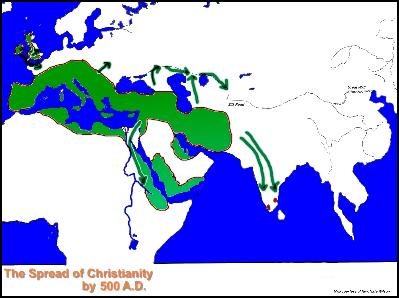 AFRICA : Church was weakened by conflict
between Donatists and Roman Catholics and then by competition with invading Vikings
who were themselves Arian “Christians”! On the other side of Africa , 9 Syrians were sent to Ethiopia , where they founded monasteries and
translated the Bible into the Ge’ez language. (Source: Elizabeth Isichei, History of Christianity in Africa )
AFRICA : Church was weakened by conflict
between Donatists and Roman Catholics and then by competition with invading Vikings
who were themselves Arian “Christians”! On the other side of Africa , 9 Syrians were sent to Ethiopia , where they founded monasteries and
translated the Bible into the Ge’ez language. (Source: Elizabeth Isichei, History of Christianity in Africa )
----------------------------------
SIXTH CENTURY
COLUMBA (c. 521-597) was born into a noble Irish
family in 521 and brought up in the Christian faith. As a young man he entered
a monastery, where he was ordained a priest. His evangelistic zeal was evident
early in his ministry, and he is credited with establishing many churches and
monasteries in Ireland . Columba’s switch from “home” missions
to “foreign” missions at the age of 42 was caused by his Irish temper. He was a
fighter as well as a saint, “a man of powerful frame and mighty voice.” His hot
temper drew him into many quarrels, at last into war with King Diarmuid, in
which 5000 men were killed. Columba, though victorious, fled from Ireland , resolved to convert as many souls as
had fallen in that battle.
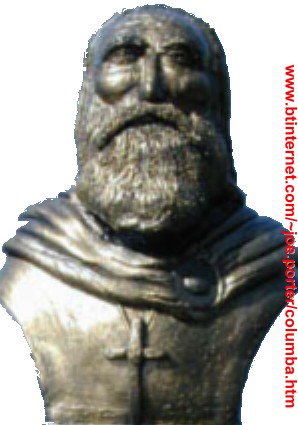 With 12 clerics to serve under him, he established
headquarters just off the coast of Scotland on Iona and established a monastery
that fostered the routine monastic life but in addition provided training for
evangelists who were sent out to preach the gospel, build churches, and
establish more monasteries. Columba himself was active in missionary work, and
traveled many times into Scotland , evangelizing the Picts in the Scottish
highlands. Brude, High King of Picts, initially refused to let him into his city,
but Columba stood by the gates and prayed until the King finally relented. Upon
entering the city, Brude’s Druid-priests challenged Columba to a duel of
paranormal powers, but Columba's feats are said to have been the more powerful
and put the Druids to shame. The Loch Ness Monster has never killed a single
soul since Columba blessed the beast that had been eating local fishermen.
With 12 clerics to serve under him, he established
headquarters just off the coast of Scotland on Iona and established a monastery
that fostered the routine monastic life but in addition provided training for
evangelists who were sent out to preach the gospel, build churches, and
establish more monasteries. Columba himself was active in missionary work, and
traveled many times into Scotland , evangelizing the Picts in the Scottish
highlands. Brude, High King of Picts, initially refused to let him into his city,
but Columba stood by the gates and prayed until the King finally relented. Upon
entering the city, Brude’s Druid-priests challenged Columba to a duel of
paranormal powers, but Columba's feats are said to have been the more powerful
and put the Druids to shame. The Loch Ness Monster has never killed a single
soul since Columba blessed the beast that had been eating local fishermen.
SOURCE: Ruth Tucker, From Jerusalem to Irian Jaya with the bit about the
Loch Ness monster by Ronald A. MacThoma <http://www.btinternet.com/~joe.porter/columba.htm>
OTHER NOTABLE MISSIONARIES IN EUROPE : Clovis converted the Franks, Augustine of
Canterbury and Ethelbert converted the Angles and Saxons late in this century
JACOB BARD - The decisive factor in the Monophysite
revival was the organizing missionary genius of Jacob Baradaeus who planted a
trail of churches across Asia , which were to spread form Syria to India , and which survive to this day and take
his name as “Jacobite” Syrian Orthodox. Jacob was born in the city of Tella in eastern Syria , about 40 miles from Edessa , near the Persian border. He entered
his ministry as an ascetic and lived in a [small] monastery near Nisibis… About
542, the king of the Ghassanid Arabs, al Harith ibn Jabadah, who served
Byzantine Rome as military governor of the provinces of eastern Syria, sent an
embassy to Empress Theodora [of Constantinople], asking, among other things,
for two Monophysite missionary bishops… She chose Jacob Baradaeus, who was
titled bishop of Edessa , and Theodore, who was made bishop of Bostra in Roman
Arabia. The latter ably served the Ghassanid Arabs, but it was Jacob who became
the Monophysite apostle to Asia .
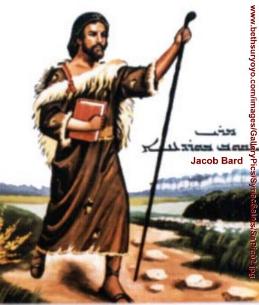 Jacob never really lived in Edessa , his episcopal seat. The police were
too hot on his trail. Justinian, not happy with his wife’s religious intrigues,
gave orders for his arrest. But for over 35 years, from 542 to 578, Jacob
eluded the spies and soldiers of the empire. He kept constantly on the move,
hastily finishing his work in any town in a day or a night and quickly moving
on before he was discovered. He traveled thirty or fourty miles a day, all on
foot. Riding a donkey or a horse, he thought, was too much of a luxury for a
missionary. Most people took him for a beggar because his clothes were so tattered
and pieced together that he was called Baradai “the patchwork man,” which is
said to be how he got his nickname… Sometimes his pursuers would meet him face
to face but not recognize him. Thinking him a beggar, they would ask, “Have you
heard any secret word about that deceiver , Jacob?” and he would say, “Yes, a
long way back of here I heard some men say that he was about, and if you hurry
perhaps you will catch him.” So they would rush off, discover nothing and be
left “beating the air… biting their fingers … and gnashing their molars against
the man mighty in the Lord,” as his biographer tells the tale.
Jacob never really lived in Edessa , his episcopal seat. The police were
too hot on his trail. Justinian, not happy with his wife’s religious intrigues,
gave orders for his arrest. But for over 35 years, from 542 to 578, Jacob
eluded the spies and soldiers of the empire. He kept constantly on the move,
hastily finishing his work in any town in a day or a night and quickly moving
on before he was discovered. He traveled thirty or fourty miles a day, all on
foot. Riding a donkey or a horse, he thought, was too much of a luxury for a
missionary. Most people took him for a beggar because his clothes were so tattered
and pieced together that he was called Baradai “the patchwork man,” which is
said to be how he got his nickname… Sometimes his pursuers would meet him face
to face but not recognize him. Thinking him a beggar, they would ask, “Have you
heard any secret word about that deceiver , Jacob?” and he would say, “Yes, a
long way back of here I heard some men say that he was about, and if you hurry
perhaps you will catch him.” So they would rush off, discover nothing and be
left “beating the air… biting their fingers … and gnashing their molars against
the man mighty in the Lord,” as his biographer tells the tale.
From Constantinople to the Persian frontier Jacob Bardai
preached, encouraged, and above all ordained , making sure that his
evangelistic efforts were not left to wither for lack of structural sinews. He
is credited by admiring Monophysite historians with ordaining and
unbelievable 100,000 clergy… (SOURCE: Samuel Moffett’s History of
Christianity in Asia p.245-246)
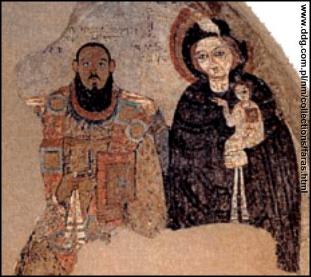 NUBIA: The eunuch whom Phillip encountered and converted was a
high official from Meroe , in the employ of Candace. In the fourth century, the
growing kingdom of Aksum conquered Meroe . In the culture that ensued,
Christianity was known, but not adopted. In one grave, for instance, a cross was
found next to charms of gold and lead. Three separate states developed in Nubia , from North to South: Nobatia,
Makouria, and Alwa.
NUBIA: The eunuch whom Phillip encountered and converted was a
high official from Meroe , in the employ of Candace. In the fourth century, the
growing kingdom of Aksum conquered Meroe . In the culture that ensued,
Christianity was known, but not adopted. In one grave, for instance, a cross was
found next to charms of gold and lead. Three separate states developed in Nubia , from North to South: Nobatia,
Makouria, and Alwa.
Christian missionaries came curiously
late to Nubia, when one considers the fervor of its Egyptian neighbors, but in
543, the Byzantine empress Theodora sent the Monophysite monk, Julian, to
Nubia. Julian converted Nobatia to Christianity, beginning with the court. So
rapid and complete was the process that it suggests either that the King
wielded great power, or that a considerable degree of prior Christian influence
existed. Makouria was converted by Chalcedonian emissaries in about 569, and
Alwa to Monophysite Christianity in 580 by Longinus, the Bishop of Philae, who
made a great detour through the desert to avoid Makouria.
Nubia was one of the few countries in the
ancient world converted to Christianity without a prior experience of Roman
rule… The Nubians used the liturgy of St. Mark, and decorated the walls of
their churches with murals that showed their royals dressed in Byzantine style.
In 1961, Polish archaeologists excavated what appeared to be a mound of sand,
and within it, found Faras Cathedral, its walls decorated with 169 magnificent
paintings of dark-skinned Nubian kings, queens, and bishops, biblical figures,
and saints… There were up to 6 Christian churches in each village, and the dead
during this Christian era were not buried with all the grave goods that the
pre-Christians had.
In the early 600’s the Arabs conquered Egypt , but they did not conquer Nubia . They were repelled by Nubia ’s brilliant archers and formed a
treaty, recognizing them as an independent, Non-Muslim state.
SOURCE: Isichei, A History of Christianity in Africa , p.30-31
Brendan, an Irish monk sailed to America in a small boat. A 1976 expedition led
by Timothy Severin set out to prove that 6th Century technology and seamanship
did have the ability to traverse the Atlantic . He set sail in a small leather-hulled boat to duplicate
St. Brendan's voyage using 6th Century methods. His success proved beyond
question that the trip was indeed possible.
Then in 1982 archeologists and ancient
language experts unlocked the key to understanding a petroglyph that had been
merely a puzzling curiosity since its discovery in 1964. A “petroglyph” is
simply a carving of words in stone. This one, located in a rock recess in Wyoming County, West Virginia, U. S. A. , was recognized by language expert
Barry Fell to be written in ancient Irish Celtic Ogam, in current use in the
6th Century in Ireland .
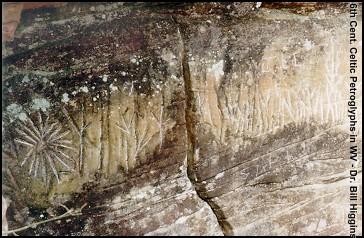 The translation of this 6th Century
Celtic Christian petroglyph reads:
The translation of this 6th Century
Celtic Christian petroglyph reads:
At the time of sunrise a ray grazes the notch on the left side on Christmas
Day. A feast-day of the Church, the First season of the (Christian) year.
The season of the Blessed Advent of the Savior, Lord Christ (Salvadoris Domini
Christi). Behold, he is born of Mary, a woman.[1]
On another panel of the petroglyph there
is a remarkably significant, though very short, inscription in the Algonquian
language, which asserts, “Glad Tidings.” We have here compelling
evidence that the Christian gospel had come to the Algonquian Indians as early
as the 6th Century! And it came to them from Ireland ! This was a full millennium before the
English missionary John Elliot, funded largely by the support of the English
Chemist Sir Robert Boyle, would once again bring the gospel to the Algonquian
Indians.
Of course, that early Celtic Christian
faith disappeared entirely from America somewhere in that intervening
millennium, and we're not sure just when, or why. But it was here, for these
American Natives, as early as the 6th Century!
Another petroglyph of the same time
period and Celtic Ogam script was found in Boone County West Virginia in the
vicinity of Horse Creek. The Horse Creek petroglyph reads:
A happy season is Christmas, a lime of
joy and goodwill to all people. A virgin was with child; God ordained her to
conceive and be fruitful. Ah, Behold, a miracle! She gave birth to a son
in a cave. The name of the cave was the cave of Bethlehem . His foster-father gave him the
name Jesus, the Christ, Alpha and Omega. Festive season of prayer. [2]
St. Brendan, according to the monastic
records, made two successful voyages across the Atlantic , and returned to Ireland to found the monastery of Clonfert in County Galway in 561. We know that his voyages
were complete before he founded the monastery, so there is a strong historical
probability that the Christian presence evidenced in America dates before AD 561. So here, as
a result of the Celtic Church , we have a church present in America , that is totally independent of the
Roman Catholic, a millennium before the Reformation.
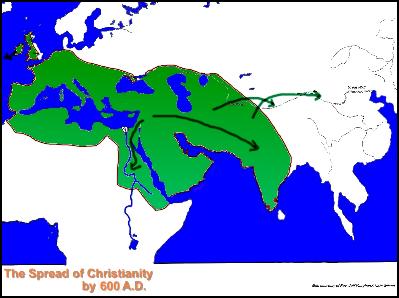 [1]Translation by Barry Fell, quoted by
Ida Jane Gallagher in “Light Dawns on West Virginia History,” Wonderful
West Virginia, March 1983 (Arnout Hyde, ed.), p. 8. See also,
Epilogue in Barry Fell, America B. C., (New York: Pocket Books,
1989), pp. 322-329. [2]Quoted by Gallagher, Op. Cit., p. 11. Translation
by Fell.
[1]Translation by Barry Fell, quoted by
Ida Jane Gallagher in “Light Dawns on West Virginia History,” Wonderful
West Virginia, March 1983 (Arnout Hyde, ed.), p. 8. See also,
Epilogue in Barry Fell, America B. C., (New York: Pocket Books,
1989), pp. 322-329. [2]Quoted by Gallagher, Op. Cit., p. 11. Translation
by Fell.
©1995, Bill Higgins, Grey Pilgrim
Publications, P. O. Box 356, Lookout
Mountain, Tennessee, U. S. A.
CHINA : Meanwhile, Nestorian businessmen made
it into China , preaching the Gospel!
-----------------------------------
SEVENTH Century
NESTORIANS IN CHINA : In about 1625 some Chinese digging the foundations of a house
near Xian, China 's ancient capital, chanced upon a black
marble monument. The Chinese characters inscribed at the top said, "The
Monument Commemorating the Propagation of the Ta-ch'in Luminous Religion in the
Middle Kingdom." Syriac characters on the stone described the arrival of a
missionary, Olopen (or Alopen), in 635. The text also named Chinese emperors
who had supported this religion and listed the religion's leaders, including
one bishop, 28 presbyters, and 38 others, likely monks…
Questions remain, however, about what
these people really believed. At best they retained the basic teachings of the
Nestorian missionaries, which already makes their theology suspect in the West.
A remote Christian outpost in the heart of Taoist country would also have been
susceptible to syncretism. In its report on Palmer's discovery, U.S. News
claims that the "uniquely Chinese brand of Christianity … mixed with
Taoism and Buddhism, differed from the Roman church by discarding the idea of
original sin, and preaching against slavery and for gender equality and
vegetarianism…"
SOURCE: Elesha Coffman, 09
March 2001
ChristianityToday.com - Christianity Today Magazine - Christian History Corner:
Digging in China , Copyright © 2001 by the author or
Christianity Today, Inc./Christianity Today magazine.
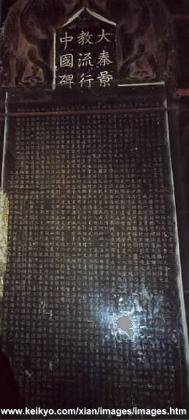 NESTORIAN TABLET:
NESTORIAN TABLET:
"Behold the unchangeably true and invisible, who existed through all
eternity without origin; the far-seeing perfect intelligence, whose mysterious
existence is everlasting; operating on primordial substance he created the
universe, being more excellent than all holy intelligences, inasmuch as he is
the source of all that is honorable. This is our eternal true lord God, triune
and mysterious in substance...
Twenty-seven sacred books [the number in
the New Testament] have been left, which disseminate intelligence by unfolding
the original transforming principles. By the rule for admission, it is the
custom to apply the water of baptism, to wash away all superficial show and to
cleanse and purify the neophytes. As a seal, they hold the cross, whose
influence is reflected in every direction, uniting all without distinction. As
they strike the wood, the fame of their benevolence is diffused abroad;
worshiping toward the east, they hasten on the way to life and glory; they
preserve the beard to symbolize their outward actions, they shave the crown to
indicate the absence of inward affections; they do not keep slaves, but put
noble and mean all on an equality; they do not amass wealth, but cast all their
property into the common stock; they fast, in order to perfect themselves by
self-inspection; they submit to restraints, in order to strengthen themselves
by silent watchfulness; seven times a day they have worship and praise for the
benefit of the living and the dead; once in seven days they sacrifice, to
cleanse the heart and return to purity…
In the time of the accomplished Emperor
Tai-tsung, the illustrious and magnificent founder of the dynasty, among the
enlightened and holy men who arrived was the most-virtuous Olopun, from the
country of Syria . Observing the azure clouds, he bore
the true sacred books; beholding the direction of the winds, he braved
difficulties and dangers. In the year of our Lord 635 he arrived at Chang-an;
the Emperor sent his Prime Minister, Duke Fang Hiuen-ling; who, carrying the
official staff to the west border, conducted his guest into the interior; the
sacred books were translated in the imperial library, the sovereign
investigated the subject in his private apartments; when becoming deeply
impressed with the rectitude and truth of the religion, he gave special orders
for its dissemination. In the seventh month of the year A.D. 638 the following
imperial proclamation was issued:
"Right principles have no
invariable name, holy men have no invariable station; instruction is
established in accordance with the locality, with the object of benefiting the
people at large. The greatly virtuous Olopun, of the kingdom of Syria , has brought his sacred books and
images from that distant part, and has presented them at our chief capital.
Having examined the principles of this religion, we find them to be purely
excellent and natural; investigating its originating source, we find it has
taken its rise from the establishment of important truths; its ritual is free
from perplexing expressions, its principles will survive when the framework is
forgot; it is beneficial to all creatures; it is advantageous to mankind. Let
it be published throughout the Empire, and let the proper authority build a
Syrian church in the capital in the I-ning May, which shall be governed by
twenty-one priests. When the virtue of the Chau Dynasty declined, the rider on
the azure ox ascended to the west; the principles of the great Tang becoming
resplendent, the Illustrious breezes have come to fan the East”
… When the Duke Koh Tsz'-i, Secondary
Minister of State and Prince of Fan-yang, at first conducted the military in
the northern region, the Emperor Suh-tsung made him (I-sz') his attendant on
his travels; although he was a private chamberlain, he assumed no distinction
on the march; he was as claws and teeth to the duke, and in rousing the
military he was as ears and eyes; he distributed the wealth conferred upon him,
not accumulating treasure for his private use; he made offerings of the jewelry
which had been given by imperial favor, he spread out a golden carpet for
devotion; now he repaired the old churches, anon he increased the number of
religious establishments; he honored and decorated the various edifices, till
they resembled the plumage of the pheasant in its flight; moreover, practising
the discipline of the Illustrious Religion, he distributed his riches in deeds
of benevolence; every year he assembled those in the sacred office from four
churches, and respectfully engaged them for fifty days in purification and
preparation; the naked came and were clothed; the sick were attended to and
restored; the dead were buried in repose; even among the most pure and
self-denying of the Buddhists, such excellence was never heard of; the
white-clad members of the Illustrious Congregation, now considering these men,
have desired to engrave a broad tablet, in order to set forth a eulogy of their
magnanimous deeds.
ODE:
The true Lord is without origin, Profound, invisible, and unchangeable; With
power and capacity to perfect and transform,
He raised up the earth and established the heavens. Divided in nature, he
entered the world, To save and to help without bounds;
The sun arose, and darkness was dispelled, All bearing witness to his true
original. The glorious and resplendent, accomplished Emperor,
Whose principles embraced those of preceding monarchs, Taking advantage of the
occasion, suppressed turbulence; Heaven was spread out and the earth was
enlarged.
When the pure, bright Illustrious Religion Was introduced to our Tang Dynasty,
The Scriptures were translated, and churches built,
And the vessel set in motion for the living and the dead;
Every kind of blessing was then obtained, And all the kingdoms enjoyed a state
of peace…
SOURCE: East Asian History Sourcebook: Ch'ing-Tsing: Nestorian Tablet:
Eulogizing the Propagation of the Illustrious Religion in China, with a
Preface, composed by a priest of the Syriac Church, 781 A.D. 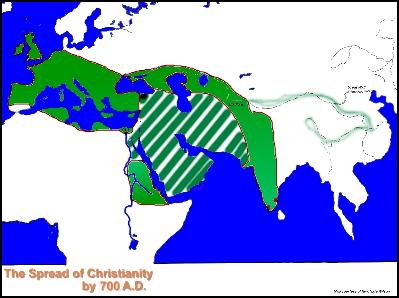 <http://www.fordham.edu/halsall/eastasia/781nestorian.html>
<http://www.fordham.edu/halsall/eastasia/781nestorian.html>
North African church fell to Islam because they were already very weak
from infighting (Romans v. Donatists, rich v. poor), invasions from the North,
and lack of missionary vision to evangelize Berbers.
------------------------------------
EIGHTH CENTURY
Read selections from Ruth Tucker’s text
“From Jerusalem to Irian Jaya” p.46-49 - mentions both
Boniface and Martel.
“Boniface was born in Devonshire England , entered monastic life as a youth, and
at the age of 30 was ordained a priest in the Roman Catholic church. Though
there were many opportunities to excel as a churchman in his homeland, his deep
concern was for the unchristianized pagans on the Continent. After an
unsuccessful tour of duty among the Frisians in Holland , he went to Rome to get the backing of the Pope. He thus
became no longer an independent missionary, but an emissary of Rome , commissioned to establish papal
authority over the church in Western Europe …
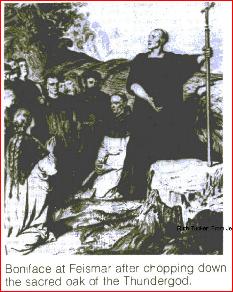 Following his return to Germany , he began his missionary work in
earnest and won a reputation for courage throughout the Rhineland . Many of the so-called Christians had
reverted to pagan practices. Boniface was convinced drastic measures were
needed, so he boldly struck a blow to the very heart of the local pagan
worship. He assembled a large crowd at Geismar, where the sacred oak of the
Thundergod was located, and with the people looking on in horror, he began
chopping down the tree… It was a master stroke of missionary policy, and
thousands of people recognized the superiority of the Christian God and
submitted to baptism. Boniface was encouraged and relieved by the positive
reaction and continued on in the same vein, destroying temples and shrines and
smashing sacred stones into bits… (In time he mellowed out though.)
Following his return to Germany , he began his missionary work in
earnest and won a reputation for courage throughout the Rhineland . Many of the so-called Christians had
reverted to pagan practices. Boniface was convinced drastic measures were
needed, so he boldly struck a blow to the very heart of the local pagan
worship. He assembled a large crowd at Geismar, where the sacred oak of the
Thundergod was located, and with the people looking on in horror, he began
chopping down the tree… It was a master stroke of missionary policy, and
thousands of people recognized the superiority of the Christian God and
submitted to baptism. Boniface was encouraged and relieved by the positive
reaction and continued on in the same vein, destroying temples and shrines and
smashing sacred stones into bits… (In time he mellowed out though.)
From his Celtic forebears, Boniface
continued the concept of monastic missions that would prepare the way for a
trained, indigenous clergy. Several monks worked with him, and as each was
assigned to a new area, a cloister was established, and training sessions were
initiated for new converts. The only truly innovative aspect of his ministry
was his enthusiastic recruitment of women to serve the cause of missions…
The phenomenal accomplishments credited
to Boniface could not have been carried out without the powerful backing of
Charles Martel, whose victory over the Muslims at the Battle of Tours in 732
marked a turning point in the struggle against Islam… (They also could not have
been carried out if it weren’t for the foundation laid by the earlier endeavors
of the Celtic and French monks of Christian communities that he won over to
Roman Catholicism.)
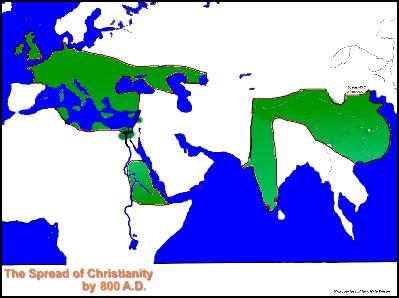 During the last years of his life,
Boniface returned to Holland to minister to the Frisians... It was there on the banks
of the river Borne that he and some 50 assistants and followers set up tents in
preparation for a confirmation service of new converts. But the service never
took place. Boniface and his companions were set upon and slain by a band of
armed pagans, thus ending the ministry of Medieval Europe’s most energetic and
outwardly-successful missionary.”
During the last years of his life,
Boniface returned to Holland to minister to the Frisians... It was there on the banks
of the river Borne that he and some 50 assistants and followers set up tents in
preparation for a confirmation service of new converts. But the service never
took place. Boniface and his companions were set upon and slain by a band of
armed pagans, thus ending the ministry of Medieval Europe’s most energetic and
outwardly-successful missionary.”
(Willibrord, was, however, successful in
converting the Frisians later on in the Century.)
CHINA : Adam (aka Ching-Ching), Nestorian monk
from Central
Asia , prolific
Bible translator, honored even by Buddhist monks. Uighurs ( Northwestern China ) declare Nestorian-Manichean
Christianity their state religion!
-----------------------------------
NINTH CENTURY
ANSKAR: Read Tucker’s text (From Jerusalem to Irian Jaya) p.49-50.
Truncated text follows:
Anskar, often referred to as the “Apostle of the North,” was born in France in
801 and schooled from the age of five at the monastery of Corbie, founded more
than two centuries earlier by Columba. A mystic moved by visions and dreams,
Anskar’s highest ambition was to obtain a martyr’s crown. Thus, he accepted his
dangerous new assignment with eagerness. His hopes of converting the Danes,
however, soon dimmed with the political and military impotence of King Harold
became apparent, and in less than three years Anskar, along with the king, was
expelled from Denmark .
 No sooner had he been forced out of Denmark than an invitation came from the king
of Sweden requesting missionaries. Anskar and another
monk immediately accepted the challenge, only to have the ship they were
sailing on attacked by pirates and all of their possessions stolen. On their
arrival in Sweden , King Bjorn warmly welcomed them and
gave them liberty to preach. He was a great preacher and founded the first
Christian church in Sweden c.832. There were many conversions,
especially among the nobility - but as in the case of King Harold, conversions
were apparently politically motivated.
No sooner had he been forced out of Denmark than an invitation came from the king
of Sweden requesting missionaries. Anskar and another
monk immediately accepted the challenge, only to have the ship they were
sailing on attacked by pirates and all of their possessions stolen. On their
arrival in Sweden , King Bjorn warmly welcomed them and
gave them liberty to preach. He was a great preacher and founded the first
Christian church in Sweden c.832. There were many conversions,
especially among the nobility - but as in the case of King Harold, conversions
were apparently politically motivated.
So significant was Anskar’s work from a
political perspective that Emperor Louis the Pious struck a deal with Pope
Gregory IV to appoint Anskar Archbishop of Hamburg for the Scandanavian and Slavic states
of Northern
Europe . To aid
Anskar in his efforts, Louis gave him a rich monastery in West Flanders , a financial source that allowed him to
bestow gifts on the provincial rulers. Anskar recruited monks from Corbie to
assist him, and Catholicism made great strides in the next dozen years. The
line between religion and politics however, continued to be a fine one, and the
gains were usually political in nature, motivated by what the Christian God and
His temporal rulers could hopefully provide…
Anskar established schools and also
campaigned against slavery. He was an ascetic at heart, and prayer and fasting
were viewed as paramount - although never to be done at the expense of useful
activity… he himself was often seen knitting while he prayed. As with most
medieval spiritual leaders he was credited with great miracles, but he
personally sought to avoid all such praise, telling others that the greatest
miracle in his life would be if God ever made a thoroughly pious man out of
him.
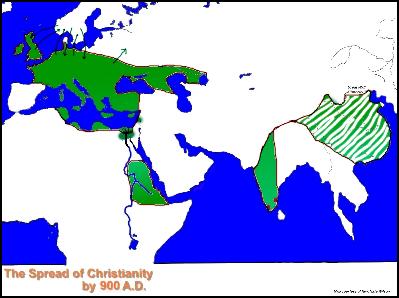 Anskar died peacefully in 865 in Bremen, Germany , without the martyr’s crown that he had
longed for. But that certainly was not the greatest prize that eluded him. In
spite of all his efforts, he was unable to establish a permanent base for
Christianity in Scandanavia. After he died, the people reverted to paganism.
Interestingly enough, it was not the missionaries, but the common Christians
captured as slaves by the Vikings who eventually succeeded in sharing the
Gospel with the Northmen and bringing them to faith in Jesus!
Anskar died peacefully in 865 in Bremen, Germany , without the martyr’s crown that he had
longed for. But that certainly was not the greatest prize that eluded him. In
spite of all his efforts, he was unable to establish a permanent base for
Christianity in Scandanavia. After he died, the people reverted to paganism.
Interestingly enough, it was not the missionaries, but the common Christians
captured as slaves by the Vikings who eventually succeeded in sharing the
Gospel with the Northmen and bringing them to faith in Jesus!
(Some details from
www.catholic-forum.com were thrown in above.)
-----------------------------------
TENTH CENTURY
ALFRED THE GREAT (849-899) was king of the West Saxons in southwestern England . He saved his kingdom, Wessex , from the Danish Vikings and laid the
basis for the unification of England under the West Saxon monarchy. He also
led a revival of learning and literature. He was such an outstanding leader in
war and peace that he is the only English king known as "the Great."
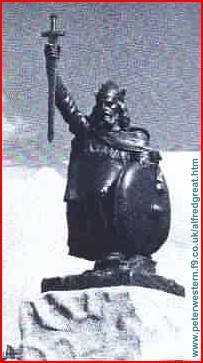 Alfred was born in Wantage, now in Oxfordshire, England . He was the youngest son of King
Ethelwulf of Wessex . According to the Welsh writer Asser,
who wrote a biography of Alfred shortly after his death, Alfred was always
eager to learn. Asser says that Alfred's mother offered a book of Anglo-Saxon
poems as a prize to the first of her sons who could read it. Alfred won. As a
boy, Alfred twice went to Rome , where the pope acknowledged the status
of the royal house of Wessex . The journeys also showed Alfred the
contrast between England and the more advanced parts of Europe .
Alfred was born in Wantage, now in Oxfordshire, England . He was the youngest son of King
Ethelwulf of Wessex . According to the Welsh writer Asser,
who wrote a biography of Alfred shortly after his death, Alfred was always
eager to learn. Asser says that Alfred's mother offered a book of Anglo-Saxon
poems as a prize to the first of her sons who could read it. Alfred won. As a
boy, Alfred twice went to Rome , where the pope acknowledged the status
of the royal house of Wessex . The journeys also showed Alfred the
contrast between England and the more advanced parts of Europe .
Alfred became king in 871 at the death
of his brother Ethelred. The West Saxons had been at war with the Danes for many years. After several
losing battles, Alfred made peace with the invaders. But the Danes renewed
their attacks and defeated Alfred at the Battle of Chippenham in 877. Alfred
then defeated the Danes at the Battle of Edington in 878. The Danish leader,
Guthrum, agreed to be baptized a Christian. He also agreed to stay north and
east of the River Thames, in an area called the Danelaw. However, the Danes
broke the peace, and Alfred renewed the war. He won London in 886. All the English people not
subject to the Danes recognized Alfred as their ruler and paid him homage. The
old, independent Anglo-Saxon kingdoms began to merge under the rule of Wessex .
Alfred built forts and boroughs
(fortified towns) at strategic points. He stationed his fleet along the coast
as protection against further invasions. He also issued a code of laws to
restore peaceful government.
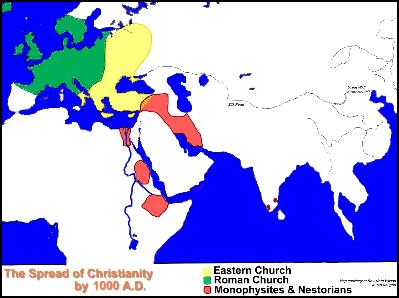 Before Alfred, education had declined in
England because the Danes had looted
monasteries and churches, the centers of learning. Alfred revived learning by
bringing teachers and writers from Wales and continental Europe . He encouraged the translation of
famous Christian books from Latin into Old English. Under his influence, the
Anglo-Saxon Chronicle began to be compiled. It is now the main source for
Anglo-Saxon history up to 1154.
Before Alfred, education had declined in
England because the Danes had looted
monasteries and churches, the centers of learning. Alfred revived learning by
bringing teachers and writers from Wales and continental Europe . He encouraged the translation of
famous Christian books from Latin into Old English. Under his influence, the
Anglo-Saxon Chronicle began to be compiled. It is now the main source for
Anglo-Saxon history up to 1154.
SOURCE: www.peterwestern.f9.co.uk
Also in Europe , there were mass conversion of the Rus
under Vladimir .
----------------------------------
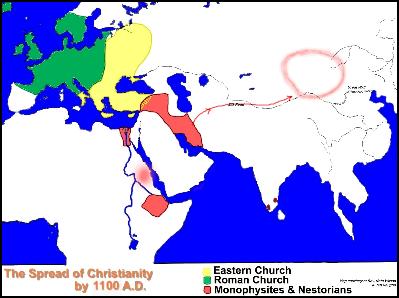 ELEVENTH CENTURY
ELEVENTH CENTURY
Prince of the Kerait tribe receives
vision, connects with Nestorian missionaries in Mongolia , and is baptized with 200,000
tribesmen. Tribe remains Christian for centuries. The Khan dynasty later comes
from this tribe.
SOURCE: Samuel Moffat, A History of
Christianity in Asia
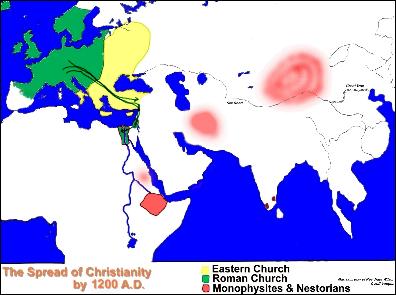
----------------------------------
TWELVTH CENTURY
Crusades against heretical Christians in
Europe , against Slavs, and against Muslims in Sicily , Spain , and Palestine end up alienating Eastern Christians
and Arabic Muslims.
----------------------------------
THIRTEENTH CENTURY
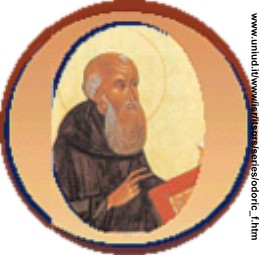 MONGOLIA: John of Plano , 1st
of seven Roman Catholic missionaries sent to the Far East , was rebuffed by Genghis Khan, but found
Nestorians in Khan’s court. Marco Polo, who was a not only a trader but also a
missionary; he visited Mongolia and also found thousands of Nestorian
Christians. Kublai Khan later requests 100 Roman Catholic missionaries, but the
pope only sends two, and those two don’t make it. The Fransiscan Friar Oderic
also makes it over to Peking in the next century, and reports Nestorian Christians there.
MONGOLIA: John of Plano , 1st
of seven Roman Catholic missionaries sent to the Far East , was rebuffed by Genghis Khan, but found
Nestorians in Khan’s court. Marco Polo, who was a not only a trader but also a
missionary; he visited Mongolia and also found thousands of Nestorian
Christians. Kublai Khan later requests 100 Roman Catholic missionaries, but the
pope only sends two, and those two don’t make it. The Fransiscan Friar Oderic
also makes it over to Peking in the next century, and reports Nestorian Christians there.
MUSLIM THREAT: In many ways, we in the 21st century are
reliving this time period as we deal with the conflict between Islam and
Christianity. Will we deal with it through warfare, like the crusades, or will
we deal with it through evangelism like Francis of Assisi? - greatest
missionary sender of this era – sent missionaries to Morocco , also travelled to Syria and Egypt himself to convert leaders there
(unsuccessfully).
Fra Ricaldo's 5 rules for missionaries
to Muslims
RAYMOND LULL (also spelled Ramon, Llul, Lully): Read
Isichei's biography on him p.55 (A
History of Christianity in Africa), but note that he won more converts than
Isichei gives him credit for. Further Biographical stuff follows (including
Isichei's information):
* Born c.1234 at Palma , Majorca
* Begin as a Seneschal, courtier and
troubadour at the court of King James of Aragon from about 1246. Married Blanca Picany
in 1257 and had two children. Lived a life of debauchery. In 1263 (in
early-30's) he received visions of Christ crucified, and was converted on the
spot.
* Lull became a Franciscan tertiary and
devoted himself to separation from the world. He was rebuked in a subsequent
vision for his self-centeredness and challenged to go out into the world and
bring the message of Christ. From that time he seemed to be inspired with
extraordinary zeal for the conversion of the Mohammedan world. He spoke of
"carrying out the task of converting to His worship and service the
Saracens who in such numbers surround the Christians on all sides."
He learned Arabic from his Muslim slave,
founded a school for Arabic study in 1276 on Majorca , and encouraged the study of Arab
language and culture. He tried to interest the Vatican and assorted European royal courts in
developing more of these training centers for missionaries to Muslims,
travelling throughout Italy , France , England and Germany in search of support, but received
little help.
* Known as an alchemist, but had no
training in occult arts, and invented his own Christian-based concepts to try
to explain the alchemical mysteries. Reputed to have solved the
"lead-into-gold" mystery; legend says he worked on it to finance
missionary work.
* Worked to convert Muslims in the Iberian peninsula , and then in north Africa. After a
false start where he "chickened-out" he finally left for Tunis around
1291 (age 60), preached to the Saracens, disputed with them in theology -
showing the deficiency of the Muslim view of God and the fullness of the
Christian view of God. Lull was stoned and ordered out of the country. After
another brief sojourn in Paris , he returned as a missionary to Bugia,
but was imprisoned and later banished. He returned to Europe in 1311 for the purpose of laying
before the Council of Vienna his plans for the conversion of the Moors. Again
in 1315 (age 83) he set out for Tunis , teaching openly and hoping to die as a
martyr. He finally died c.1315. Some writers indicate he was martyred by
stoning in Tunis , others that he was stoned in Bugia, still others that
he died of natural causes during the return ocean voyage from Tunis .
* Lull wrote over 300 works in Latin,
Arabic and Catalan (Castilian Spanish?) on theology, logic, philosophy; wrote
fiction and poetry. Raymond's literary activity was inspired by the same
purpose as his missionary and educational efforts. He strove to show the errors
of Averroism and to expound Christian theology in such a manner that the
Saracens themselves could not fail to see the truth. He especially wanted to
convince Muslims with their "bald Monotheism" of the truth of the
Trinity. With the same purpose in view, he invented a mechanical contrivance, a
logical machine, in which the subjects and predicates of theological
propositions were arranged in circles, squares, triangles, and other
geometrical figures, so that by moving a lever, turning a crank, or causing a
wheel to revolve, the propositions would arrange themselves in the affirmative
or negative and thus prove themselves to be true. This device he called the Ars
Generalis Ultima or the Ars Magna, and to the description and
explanation of it he devoted his most important works. Underlying this scheme
was a theoretical philosophy, or rather a theosophy, for the essential element
in Raymond's method was the identification of theology with philosophy...
 The Arabians had completely separated
them by maintaining the twofold standard of truth, according to which what is false
in philosophy may be true in theology. Raymond, carried on by his zeal for the
refutation of the Arabians, went to the opposite extreme. He held that there is
no distinction between philosophy and theology, between reason and faith, so
that even the highest mysteries may be proved by means of logical demonstration
and the us of the Ars Magna. This of course removed all distinction between
natural and supernatural truth.
The Arabians had completely separated
them by maintaining the twofold standard of truth, according to which what is false
in philosophy may be true in theology. Raymond, carried on by his zeal for the
refutation of the Arabians, went to the opposite extreme. He held that there is
no distinction between philosophy and theology, between reason and faith, so
that even the highest mysteries may be proved by means of logical demonstration
and the us of the Ars Magna. This of course removed all distinction between
natural and supernatural truth.
"Relying on the grace of God",
he writes, "I intend to prove the articles of faith by convincing
reasons" ("Opera", Strasburg ed., p. 966). On the other hand, he
held that, although reason needs the Divine assistance, faith is just as much
in need of reason; faith may deceive us unless reason guides it. He who relies
on faith alone is like a blind man who, relying on the sense of touch, can
sometimes find what he wants but often misses it; to be certain of finding his
object he needs sight as well as touch. So Raymond held that a man, in order to
find out the truth about God, must bring reason to the task as well as faith.
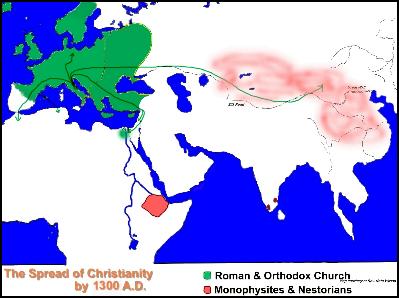 * For all his exertions and learning, he
made, as far as we know, no impact on North Africa . He did not even convert his Muslim slave, who remained
hostile to Christianity, and finally hanged himself. He did, however make some
converts along the way.
* For all his exertions and learning, he
made, as far as we know, no impact on North Africa . He did not even convert his Muslim slave, who remained
hostile to Christianity, and finally hanged himself. He did, however make some
converts along the way.
SOURCES:
http://www.catholic-forum.com/saints/saintr73.htm, WILLIAM TURNER
http://www.newadvent.org/cathen/12670c.htm, Isichei's A History of
Christianity in Africa, and Tucker's From Jerusalem to Irian Jaya
All maps except the first were designed by Rev. Nate Wilson with help from Rev. Jeff Vauhn and Mr. Beni Wilson. Nate Wilson is also the compiler and editor of this paper. For source information on the pictures, right-click on the picture and select "Properties" to reveal the source URL.

 Apostle Simon the Zealot: Most legends
place his missionary work in Egypt (with Mark). According to a
sixth-century apocryphal tradition, he preached the Gospel in Persia with Jude (Judas Thaddaeus), where they
were both martyred.
Apostle Simon the Zealot: Most legends
place his missionary work in Egypt (with Mark). According to a
sixth-century apocryphal tradition, he preached the Gospel in Persia with Jude (Judas Thaddaeus), where they
were both martyred. 





























